Camponotus manabo
| Camponotus manabo | |
|---|---|

| |
| Scientific classification | |
| Kingdom: | Animalia |
| Phylum: | Arthropoda |
| Class: | Insecta |
| Order: | Hymenoptera |
| Family: | Formicidae |
| Subfamily: | Formicinae |
| Tribe: | Camponotini |
| Genus: | Camponotus |
| Subgenus: | Mayria |
| Species: | C. manabo |
| Binomial name | |
| Camponotus manabo Rakotonirina & Fisher, 2018 | |
Endemic to Madagascar, C. manabo is geographically recorded from the eastern rainforests and montane rainforests of Madagascar. Its distribution ranges from Ambanizana in the north to the Corridor Forestier Analamay-Mantadia, Ambatoharanana in the center through the Vevembe Forest and down to Ivohibe Forest in the south. Worker specimens have been found foraging mostly on the ground and in leaf litter, and nest sites are in rotten logs.
Identification
A member of the subgenus Mayria (see diagnosis). Rakotonirina and Fisher (2018) - Median portion of clypeus with a longitudinal carina; in lateral view, mesosoma short and high; body entirely dark brown to black without any white spots, dorsum of mesosoma covered with 15 to 20 long erect hairs and scattered short pubescence; anteromedian margin of clypeus broadly convex; dorsal margin of petiolar node convex.
Camponotus manabo can be distinguished from the other species in the Mayria group by the presence of median longitudinal carina on its clypeus, the short and high mesosoma, and the existence of numerous erect hairs and a small quantity of short pubescence on the dorsum of the mesosoma.
Keys including this Species
Distribution
Latitudinal Distribution Pattern
Latitudinal Range: -15.58506° to -24.569°.
| North Temperate |
North Subtropical |
Tropical | South Subtropical |
South Temperate |
- Source: AntMaps
Distribution based on Regional Taxon Lists
Malagasy Region: Madagascar (type locality).
Distribution based on AntMaps
Distribution based on AntWeb specimens
Check data from AntWeb
Countries Occupied
| Number of countries occupied by this species based on AntWiki Regional Taxon Lists. In general, fewer countries occupied indicates a narrower range, while more countries indicates a more widespread species. |

|
Estimated Abundance
| Relative abundance based on number of AntMaps records per species (this species within the purple bar). Fewer records (to the left) indicates a less abundant/encountered species while more records (to the right) indicates more abundant/encountered species. |

|
Biology
Castes
worker
Images from AntWeb
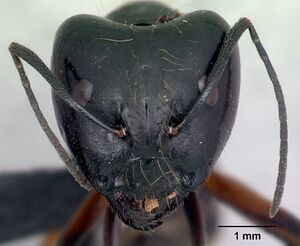 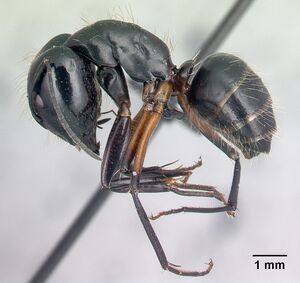 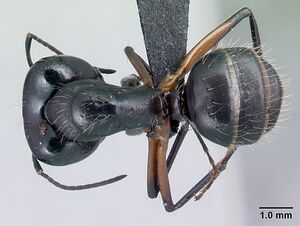 
| |
| Worker (major/soldier). Specimen code casent0496382. Photographer Erin Prado, uploaded by California Academy of Sciences. | Owned by CAS, San Francisco, CA, USA. |
Male
Images from AntWeb
  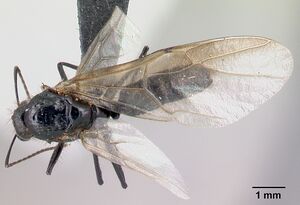 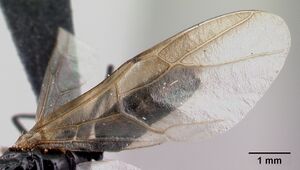 
| |
| Male (alate). Specimen code casent0496379. Photographer Erin Prado, uploaded by California Academy of Sciences. | Owned by CAS, San Francisco, CA, USA. |

| |
| Worker (major/soldier). Specimen code casent0496382. Photographer Erin Prado, uploaded by California Academy of Sciences. | Owned by CAS, San Francisco, CA, USA. |
Nomenclature
The following information is derived from Barry Bolton's Online Catalogue of the Ants of the World.
- manabo. Camponotus manabo Rakotonirina & Fisher, 2018: 43, figs. 5A, 29, 37 (s.w.) MADAGASCAR.
- Type-material: holotype worker (caste not indicated), 1 paratype minor worker.
- Type-locality: holotype Madagascar: Toamasina, Bevolota, 17.1 km. N Andasibe, -18.77071, 48.43164, 995 m., 12.xii.2007, BLF19324 (B.L. Fisher, et al.); paratype with same data.
- Type-depository: CASC.
- Combination in C. (Myrmonesites): Rasoamanana & Fisher, 2022: 147.
- Distribution: Madagascar.
Unless otherwise noted the text for the remainder of this section is reported from the publication that includes the original description.
Description
Worker
Minor. In full-face view, head elongate, lateral margin straight and diverging posteriorly, rounding to the slightly medially excised posterior margin. Anterior clypeal margin broadly convex; median carina short and located in its posterior quarter. Eyes not breaking lateral outlines of head; their posterior margins located far behind the mid-length of the head (PoOc/CL: 0.27±0.01; 0.25–0.28). Mandible triangular, apical margin with six sharp teeth. Antennal scape long, roughly its distal half extending beyond posterior cephalic border. In lateral view, dorsal outline of mesosoma a continuous convexity; propodeal dorsum rounding to declivity surface; propodeal dorsum roughly twice as long as the declivity is high; propodeal spiracle slit-like. Petiolar node higher than long, its dorsal margin convex.
Dorsum of mesosoma covered with whitish, elongate, erect hairs of the same height as propodeal declivity and sparse short pubescence. Body color entirely black and appendages reddish-black.
Major. Differing from minor worker in the following characters: enlarged head with noticeably concave posterior margin; robust mesosoma, with distinct metanotum, propodeal dorsum twice as long as height of declivity; petiolar node tapering dorsally.
Type Material
Holotype worker. Madagascar: Province Toamasina, Bevolota 17.1 km N Andasibe, -18.77071, 48.43164, 995 m, ex rotten log, montane rainforest, 12 Dec 2007 (B.L. Fisher et al.) collection code: BLF19324, specimen code: CASENT0135055 (California Academy of Sciences). Paratype. 1 worker with same data as holotype but with specimen code: CASENT0135056 (CASC).
References
- Rakotonirina, J.C., Fisher, B.L. 2018. Taxonomic revision of the Malagasy Camponotus subgenus Mayria (Hymenoptera, Formicidae) using qualitative and quantitative morphology. Zootaxa 4438: 1–58 (doi:10.11646/zootaxa.4438.1.1).
- Rasoamanana, N., Fisher, B.L. 2022. A taxonomic revision of the Malagasy endemic subgenus Mayria of the genus Camponotus (Hymenoptera, Formicidae) based on qualitative morphology and quantitative morphometric analyses. ZooKeys 1081: 137–231 (doi:10.3897/zookeys.1081.71872).

